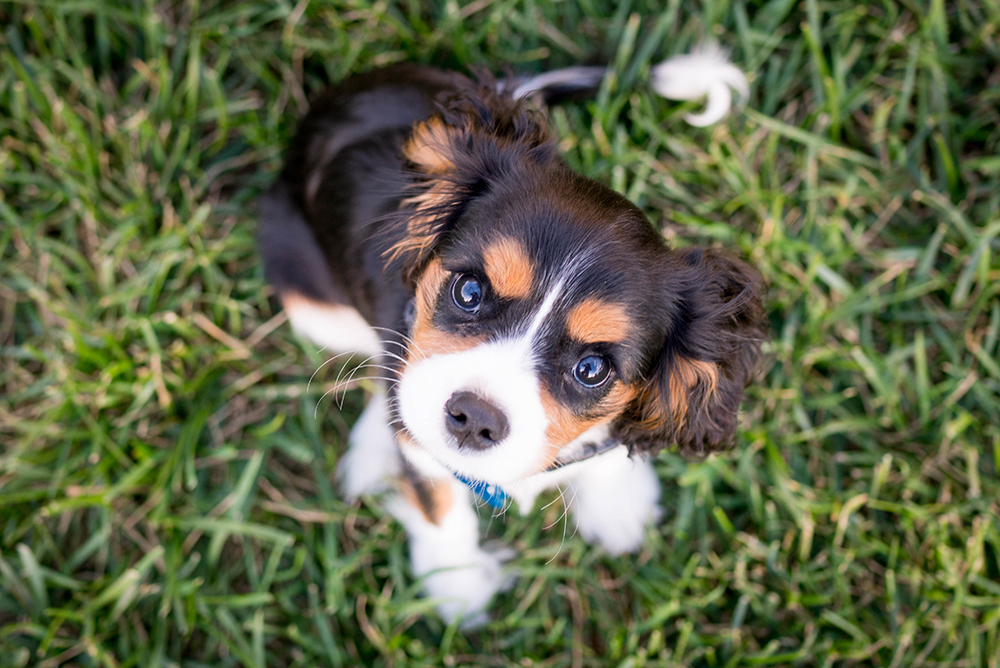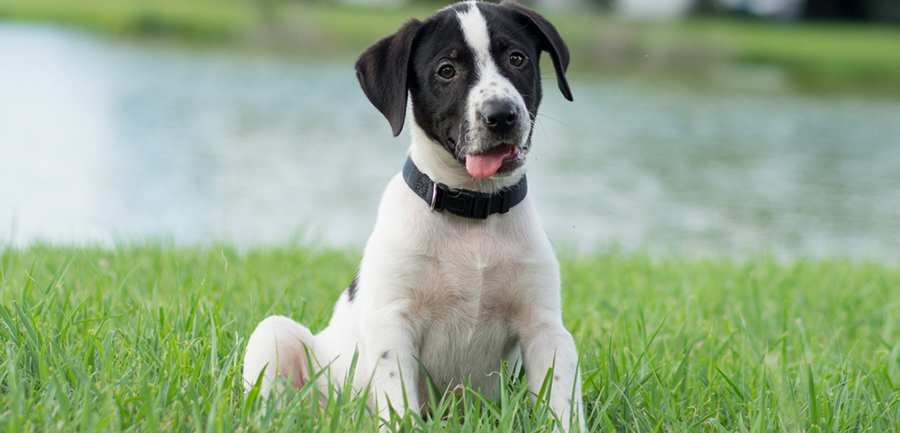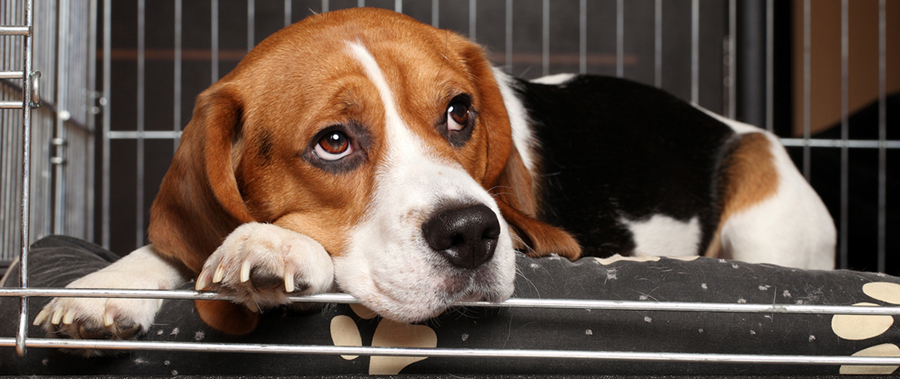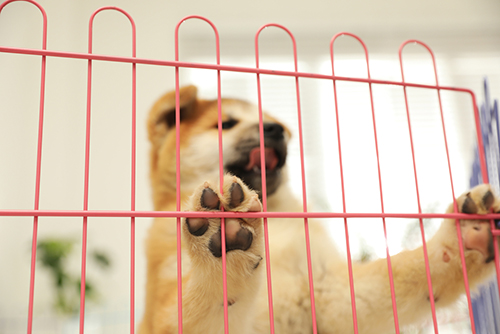
In this article
From the puppy pads in the house to the leashed walks around the block, puppy potty training is a task that requires a consistent schedule (and quite a bit of patience). This guide will break down everything you need to know to get your puppy trained.
As you read, keep in mind that there are various factors that will affect when your puppy needs to go. If your puppy has an accident out of the blue, consider any changes to the following factors:
- Frequency of feeding
- Setting up ques
- Naps and Playtimes
Steps for Potty Training Your Puppy

Begin puppy potty training when your pup is 12 to 16 weeks old. This is when your puppy has begun to have more control of their bladder and bowel movements. Teaching a puppy when and where they can go from a young age is important for avoiding behavior problems down the road.
Follow these steps to potty train your puppy:
Step 1: Build a Routine
Getting yourself and your puppy into a routine can make potty training a cinch. Eventually, your pup will pick up on the routine you design. They’ll learn what time you usually wake up and when you normally take breaks to let them out.
Keep in mind, you’ll need to go for more frequent potty breaks while your puppy is young since their bladder can’t handle waiting very long. As they age you’ll be able to go longer without needing to drop everything and take them for a walk.
Here’s a basic potty training schedule to guide your day and prompt you to prompt your puppy it’s time to go out:
When You Wake Up
As soon as you get up in the morning, take the puppy out of their crate and bring them outside to the designated spot. This will start both of your days off on the right paw.
Make sure you’re not hanging around, waiting for the coffee to brew, or getting completely ready for the day first. Throw on some shoes and head for the door as soon as you’re awake to help reduce the chances your puppy has an accident.
Remember, they’ve gone the whole night having to hold it. That’s a long time for a little puppy to wait.
Tip
Go to the same area every single time. Take the same path every single time. This familiarity and routine will help your puppy better understand it’s time to eliminate.

After Meals
Take your puppy out after every meal. They definitely have something in their system they’ll need to eliminate. Waiting too long after a meal can turn into an accident which will undo all the work you’ve already done.
These after meal potty breaks should be at about the same time each day as your puppy should be on a regular eating schedule.
Tip
Aim to make after meal breaks 5 to 30 minutes after your puppy finishes eating.
When Your Puppy Wakes Up From Naps
Just like when you take your puppy out in the morning, you should take your puppy out when they wake up from naps. You’ll want to take them out as soon as they wake up to reduce the risk they have a sudden accident.
After Playtime
Your puppy may ‘forget’ they need to go while they’re playing. Jumping and running around may also cause them to need to go. Whether your puppy actually ends up needing to eliminate after playtime or not, it’s better to give them the opportunity to go.
Before Leaving Home
When you have a tiny, furry canine to watch out for you’ll need to try and plan your outings around how long they can hold it. Always make sure you take your puppy out before leaving for an extended period of time.
If you’re not sure how long your pup can go without needing a potty break, adhere to the month-plus-one guidelines. This suggests your puppy can hold it for their age in months plus one hour. (Note: Some suggest an hour for every month of age rather than the month-plus-one rule.)
Puppy Potty Training Chart
| Age of Puppy | Maximum Time Between Potty Breaks |
|---|---|
| 2 Months | 3 Hours |
| 3 Months | 4 Hours |
| 4 Months | 5 Hours |
| 5 Months | 6 Hours |
| 6+ Months | 6 – 8 Hours |
Before Bed
Before you hit the hay, take you and the little pup out for another trip to the outdoor potty to prevent overnight accidents. This will help get your pet in the routine of having a final trip out each night.
Step 2: Set Up a Que
Setting up a queue can teach your dog to let you know if there is ever a time where they need to go ASAP. Most commonly, pets are taught to bark, ring a bell, or sit by the door when they need to go out. Having an obvious queue can help your puppy prevent accidents as you may miss other, less noticeable signs when they need to go out.
Step 3: Take Your Puppy to the Same, Distraction-free Spot Each Time
So you and your puppy made it outside without any accidents. Now what? Your puppy may not quite understand why you’ve rushed them out the door. To help your puppy understand it isn’t playtime, you’ll need to keep a few things in mind:
- Always take your pup to a secluded area (fewer distractions, higher chance they’ll go potty)
- Try to stick to the same spot every time you take them out
- Be boring—don’t play with your puppy or pay attention to them to limit distractions
- Don’t get frustrated or yell at them in an effort to get them to do what you want
Remember, your puppy may not go every time you take them outside. This isn’t the end of the world. If there’s no success then go back inside and try again later. Eventually, your pup will figure out what the desired routine is.
But, if your puppy does go while you’re outside you want to reward them for their good behavior. This is an even stronger reward with the juxtaposition to your previous, boring pre-potty self.
Step 4: Use of a Crate When You’re Not Home

Using a crate while potty training your puppy can be helpful for preventing accidents and can actually control where they go while learning. While everyone would love to stay at home with their pets all the time, for most people it isn’t possible.
Crate training gives your puppy an area that is just for them. This plays into a dog’s natural instinct to keep their space clean. They will avoid having accidents in a crate that is appropriate for their size.
Warning: This is not a magic solution. A puppy’s bladder and bowel control will not defy logic when in a crate, you still need to be home to let them out at appropriate intervals.
Step 5: Properly Reward Your Puppy
Always reward your puppy for eliminating in appropriate areas. This will require you to be prepared to anticipate when your puppy needs to go out.
When your puppy has eliminated, immediately reward them with a small treat (we recommend training treats to avoid giving your puppy too much ‘junk food’). You can also implement clicker training at this point by marking the action with a click followed by a treat.
Time is everything. You should make sure you aren’t giving the reward too soon as this can disrupt and distract from the positive action you’re trying to reinforce. Too late and your puppy just things you’re giving out random treats.
Potty Training Your Puppy When…
You Live in an Apartment
Unless you live on the first floor of an apartment with an easily accessible backyard green space, you’ll be facing extra obstacles when potty training your new puppy. Routines and backup plans are your best friend when you live on Floor 2 and beyond.
Puppy pee pads and doggy litter boxes are a good option when your puppy simply isn’t going to make it. Dog litter boxes are synthetic grass and can be placed on a balcony or in-home like you would a cat litter box. You can DIY this or go with one of the many store-bought variations.
It’s a good idea to carry your puppy in the elevator down instead of letting them wander on the ground. While there’s a chance they will pee on you, they’re much more likely to hold it a bit longer if you’re holding them than if they’re on the ground.

You Don’t Have a Crate
Potty training is pretty much the same with or without a crate while you’re home, it’s when you leave the home that you’ll need to make some decisions. Potty training your pup without a crate is inevitably much easier if you work from home. But when you do leave the house you’ll need to set up the following for your pup while you’re away:
- Decide on a room or penned off area to contain your puppy while you’re away. (You might need doggy gates for this.)
- If you decide to use puppy pads, keep them in one spot not spread everywhere.
- Train your pup to use the puppy pads while you’re gone and be sure to quickly replace any soiled ones.
Tip
Use an enzymatic cleaner that breaks down even the tiniest of potty stains to ensure they do not associate certain spots with pee and thus decide that spot is an okay spot to go.
You Have to Work
If you work long hours potty training can be a bigger hurdle than for those working short shifts or from home offices. Those working full-time often put off adopting a young puppy to avoid potty training struggles. With the following in mind, remember your puppy’s potty training progress will likely be slower when you aren’t able to build a routine and let them outside regularly.
You’ll want to determine if you can come home on lunch breaks to let your puppy out and keep up the potty training schedule. Otherwise, your best bet is to hire a qualified dog sitter. They can either stay with your puppy all day or drop in as a dog walker would for a midday walk.
While you’re at work, set your pup up in a safe puppy-proofed area of the home with puppy pads.
When to Begin Potty Training Your Puppy
A puppy will typically be ready to train when they are between 12 to 16 weeks old. At this point, they have enough bladder control to be trained on when to go out.
Warning: In an effort to avoid parvovirus, you’ll want to make sure your puppies have been given all the necessary shots before letting them wander outside.
How Long Does it Take to Potty Train a Puppy?
On average, it takes roughly four to six months to completely potty train a puppy. As you move into the four and six-month marks, your puppy will be close to completely potty trained but accidents are still likely to occur. To cut down on the time it takes to have your puppy completely potty trained, avoid punishing your puppy for accidents, and use positive reinforcement when they eliminate in the designated area.
How to Potty Train Your Puppy Fast
If you’re trying to potty train fast you’ll need to be available to let your pup out every hour of the day. If you have the right schedule and a puppy who’s an especially quick learner, potty training can be accomplished in seven to fourteen days. We want to stress, however, that this is not the norm.
Don’t go into potty training expecting a quick solution. The best way to speed up potty training is with positive reinforcement. Incorporate frequent potty breaks and stay with your pup at all times to monitor for signals they need to go out.
Frequently Asked Questions
Can an eight-week-old puppy be potty trained?
Eight weeks is still a bit too young to realistically potty train your pup. At best they can hold their bladder for two to three hours. At eight weeks you can do your part to get them where they need to be to go—don’t expect them to notify you they need to go out. You can begin establishing routines for yourself and, as your puppy ages, they will begin to pick up on the potty schedule.
What is the hardest dog breed to potty train?
You can’t make generalizations set in stone when it comes to dog breeds. But, most dogs of a specific breed will have similar temperaments. Because of this, the hardest dog breeds to potty train are usually Jack Russell Terriers and Yorkshire Terriers.
It comes as no surprise that these ‘harder to train dogs’ are also smaller dog breeds. Small and toy dog breeds are known for being a bit trickier to potty train. This is often attributed to their smaller size and faster metabolism.
Signs Your Puppy Needs to Eliminate

As your puppy begins to associate outside with the right place to eliminate they will find ways to signal to you if you haven’t already taught them to us a bell or bark at the door. Watch out for the following common signs your puppy needs to be let out:
- Circling and whining
- Sniffing and licking their groin or rear
- Scratching or sniffing at the door
- Returning to a spot in the house where they previously eliminated
Tip
It’s better not to wait until you notice obvious signs your pup needs to go out, especially when you’ve just started potty training. Take your pup out at regular intervals to avoid the possibility of accidents.
How to Deal With Accidents
Dealing with accidents starts and ends with not punishing your puppy for their mistake. No, rubbing their nose in urine isn’t going to magically potty train them even if you’re frustrated.
If you catch your puppy in the act of having an accident in the house, make a sudden noise to distract them (not yelling at them). This should momentarily get them focused away from having an accident and give you time to swoop in a get them outside. Once they eliminate outside reward with a treat.
Be sure to thoroughly clean the area after an accident to remove any urine scent. You’ll need a cleaner stronger than your traditional surface cleaner to completely remove the smell.
Do’s and Don’ts of Potty Training Puppies
If you’re a first-time puppy owner and in charge of potty training, here are some do’s and don’ts you should follow:
- DO reinforce positive behavior as this shows the puppy when they are doing the right thing.
- DON’T punish them by rubbing their nose in accidents, this is cruel and they do not understand it.
- DO recognize that accidents happen and there might be medical reasons for them.
- DON’T neglect your puppy and think they have a bladder of steel—no one does.
- DO give them the time they need to learn and always act with patience and kindness.
There is no set amount of time that it takes for a puppy to be potty trained. Give them the time and patience that they deserve and you’ll be in for a lifetime of happy licks and tail wags.
Essential Potty Training Tools
Raising a puppy is full of surprises (many of them monetary) and potty training is no exception. Before you bring a puppy home, consider the following tools you’ll need to buy and the price tag that comes with it:
Potty Training Supplies
| Product | Price |
|---|---|
| Leash & collar | $8 – $20 |
| Dog crate | $25 – $100 |
| Playpen | $30 – $100 |
| Baby gates | $20 – $30/pack |
| Training treats | $3 – $8/bag |
| Poop bags | $6 – $10/pack |
| Pooper scooper | $10 – $20 |
| Cleaning products | $8 – $16/ea. |
| TOTAL | $130 – $354 |
While you can certainly find cheaper (or pricier!) alternatives, you can usually expect to pay between $130 and $354 for supplies when you get started with potty training your pup.
Potty Training Older Dogs

Your new four-legged friend isn’t a puppy and also isn’t potty trained. Now what?
Don’t fear, potty training older dogs is much easier than potty training a young pup. Whether your dog has never lived indoors, the previous owner never bothered to train them, or they have always used paper or concrete in a pen, we’ll run you through the ropes of bringing you senior dog up to speed on potty training.
Just like with puppies, your senior dog needs a firm routine. This includes going out at specific times and having meals at regular hours.
Avoid free-feeding as you won’t be able to monitor when your dog likely needs to go. When you do take your adult dog out you’ll want to stay with them or keep them on a leash. This lets you monitor if they’ve actually eliminated.
Some dogs may have never gone on grass or dirt if their lives were spent on concrete. If you’re having a particularly difficult time teaching a dog to eliminate in the grass, you can have a friend’s dog or a dog park help you out. Your dog is more likely to go in a spot where another dog has gone.
Remember not to get frustrated. Your dog only wants to please you and may have developed habits due to previous neglect or abuse.
Warning Signs to Watch Out For
Even after your dog is a pro at knowing when and where to go, you should keep an eye on their urine and stool. It may seem gross, but as a pet owner it can actually help you monitor your pet’s health.
Noticing continuous diarrhea, blood when urinating or defecating, and other warning signs can help you catch problems before they progress to more severe and obvious symptoms.
Keep an eye out for:
- Increased amount of urine
- Increased frequency in elimination
- Blood in either urine or stool
- Change in consistency of stool
- Straining
- Discoloration of urine or stool
The changes in your dog’s elimination could be caused by anything from separation anxiety to Cushing’s disease. Certain medications your pet is on can also affect their elimination (which will likely be addressed upon prescription).
If you notice unusual or alarming changes it’s best to contact your veterinarian immediately. Your vet will be able to conduct a urinalysis, CBC, fecal sample analysis, or any other necessary testing to determine the root cause.
If you’re concerned about behaviors to symptoms your puppy is exhibiting give us a call to schedule an appointment. It’s always better to check the symptoms early on rather than wait until problems worsen.




